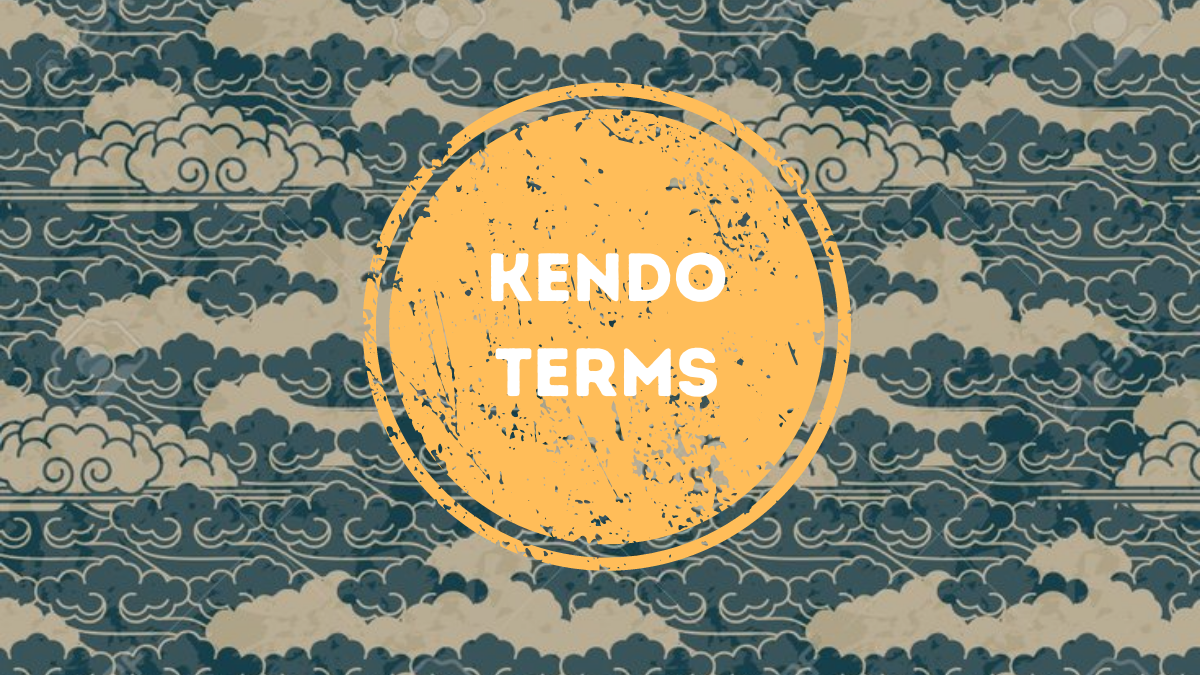
The language of Kendo
Being of Japanese origin, most if not all the terms used in kendo are Japanese. Here is an introduction to some of these terms and the English meaning
Equipment A more detailed description of the equipment is found on the equipment page
Bogu :- Kendo armour, consists of men, kote, do and tare
Men:- Protective head guard/mask, also the call (kiai) for a strike to the head
Kote:- Protective gloves, also the call (kiai) for a wrist strike
Do:- Torso protector, also the call (kiai) for a strike to the torso
Tare:- Protective apron [not a scoring area]
Shinai:- Bamboo foil
Bokuto (or bokken):- Wooden sword [usually in pairs: Odachi- long sword. Kodachi- short sword]
Tsuba:- Hand guard on a sword, shinai or bokuto
Tenugui:- Cotton towel worn on the head underneath the Men.
Kendo-i:- Practice jacket, also known as a kendo gi
Hakama:- Traditional japanese loose pleated trousers
People, Names These words are used to describe people or roles in the dojo
Sensei:- refers to a Teacher or Teachers
Senpai:- Senior students of the Dojo
Uchidachi:- ‘Striking Sword’ leading or the teaching role in kata
Shidachi:- ‘Responding Sword’ following or the learning role in kata
Motodachi:- The one who takes the role of instructor for the trainee practising kihon-geiko, kakari-geiko and ji-geiko (like Uchidachi in Kata)
Kakarite:- The opposite to motodachi in shinai kendo ( like shidachi in Kata)
Aite:- An opponent, or a person (partner) who helps one’s training
Explanation of the Ranking sytem – Kyu, Dan & Shogo
Kyu (Beginner): A grading system before Shodan (First Degree)
Dan (Degree): This indicates over-all kendo abilities including techniques and mentalities (attitudes).
Shogo (Title): This indicates the degree of completion as a Kendoist. In addition to the conditions of Dan, one must have instructional abilities and knowledge of Kendo.
Renshi: Those who have practiced and succeeded to show the principle of the sword and have good knowledge of Kendo – Must have 6th Dan.
Kyoshi: Those who have mastered the principle of the sword and have excellent knowledge of Kendo – Must have 7th Dan.
Hanshi: The highest of all. Those who have mastered and completed the principle of the sword, have outstanding knowledge of kendo together with an excellent and virtuous personality – Must have 8th Dan.
Techniques, Stances etc.These are words that describe ways of standing, moving or doing things. They often get shouted out in the dojo with little explaination so this should help those people who haven’t learnt them yet.
Kata:- Pre-determined forms using bokuto, used as a basic training method for sword techniques.
Keiko:- Practice, originally to study (kei) ancient times (ko) this term is used for the practice of bugei(martial arts) and gei-goto (arts). This word doesn’t simply mean repeating the practice, it also includes the importance of one’s attitude to the art being studied. The process is also connected to the everyday life and the endeavours of creating a new self through the unification of these two elements (art and life).
Keiko-ho:- A method to aquire skills
Kihon-geiko:- The act of practicing to acquire the basic movements(also known as kihon-renshu)
kata-geiko:- The practice of kata
Kakari-geiko:- The keiko method of striking the motodachi in an all out attack, using all of the waza learned, without thought of being counter cut or blocked (the motodachi will receive without hindrance), should be carried out in short physical bursts only, with a good recovery time allowed between each burst
Ji-geiko:- The general method of practice in which the trainee attempts to practice freely, refining technique, disciplining the mind and trying to overcome their weakness points
Uchikomi-geiko:- A method to learn basic techniques of striking by responding to opportunities (openings) given by the motodachi
Gokaku-geiko:- Keiko practiced by persons who are almost equal in skills. This term also applies for keiko where the participants treat each other with equal respect, even if there is a difference in their skills
Kiri-kaeshi:- A comprehensive way to practice basic movements, by striking men continously (front, left and right), whilst maintaining good posture with full body/mind co-ordination and utilising the kiai to assist the breathing pattern. This is an important practice method for both beginners and the experienced. The word kiri-kaeshi also refers to a counterstrike in which the direction of the strike changes
Waza:- Technique, skill
Ki-ai:- Spirit, Shout. More fully the state of mind where one is fully focused on the opponent’s move and one’s planned moves. It also refers to the vocalizations one produces when in this state of mind
Kamae:- Stance of readiness [fighting position]
Chudan Kamae:- Middle level stance [sword held at chest height]
Jodan Kamae:- High level stance [sword held raised above the head]
Gedan Kamae:- Low level stance [sword held pointing at the ground]
Rei:- Bow of respect [Ritsu-rei- while standing. Za-re- while sitting]
Sensei ni rei:- Bow to the teacher
Sensei gata ni rei:- Bow to the teachers (more than one)
Ota-gai-ni-rei:- Mutal bow to each other
Sei-re-tsu:- Stand in a line
Sei-za:- a way of sitting on your knees [position], also the call to sit down (in seiza) when standing in a line
Kio-tsuke:- sit up straight
Ki-ri-tsu:- Stand up
Haji-me:- Start or begin
Yame:- Stop or finish
Sonkyo:- Traditional crouch like stance/position for starting and finishing
Osa-me-to:- Put your sword away [sheath it] also called –Osameru
Tai-to:- Sword held at waist height, as if in your belt or sash [obi]
Sage-to (also known as Tei-to):- Sword in a hanging position at your side
Ma or Maai:- Distance
Mae:- Forward
Ato:- Backward
Migi:- Right
Hidari:- Left
Suburi:- Cutting movements
Te-no-uchi:- The tightening/loosening of the hands when striking or responding. An adjustment of balance between the two hands when gripping the shinai
Men tsuke:- Call to put on your Men
Men to-re:- Call to take off your Men
Rei-ho:- Courtesy in Kendo (etiquette)
Moku-so :- the act of composing your mind body and spirit through breathing, whilst in the seiza position
Ashi Sabaki: – Footwork
Suri-ashi:- Sliding footwork
Okuri-ashi:- Step forward or backward by using suri-ashi
Ayumi-ashi:- a usual walking Step
Hiraki-ashi:- Stepping diagonally or sideways
Tsugi-ashi:- Drawing left foot up to your right and then stepping forward again on your right foot
Fumi-Komu:- To stamp the floor with the front foot
Fumi-komi ashi:- The foot which stamps the floor with the entire sole of the foot
Fumi-komi-dosa:- The movements performed by fumi-komu
Counting
Ichi – one
Ni – two
San – three
Shi – four
Go – five
Roku – six
Shichi – seven
Hachi – eight
Ku – Nine
Ju – ten
Ju-Ichi – eleven,
Ju-Ni– twelve etc.
Ni-ju – twenty
